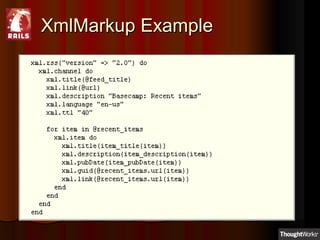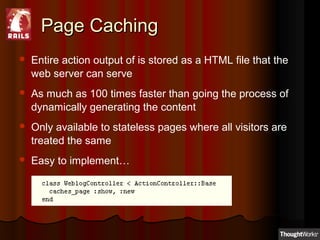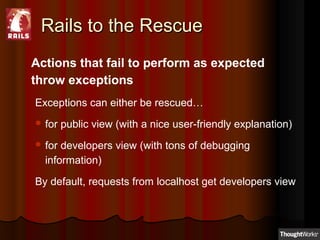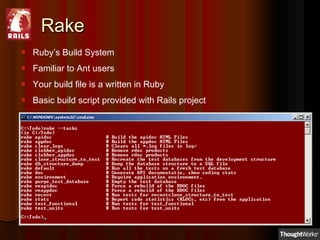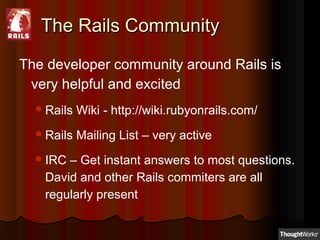Ruby on rails
- 1. Ruby on RailsRuby on Rails Presentation to Agile Atlanta GroupPresentation to Agile Atlanta Group Originally presented May 10 ‘05Originally presented May 10 ‘05 Obie Fernandez Agile Atlanta Founder / ThoughtWorks Technologist
- 2. IntroductionIntroduction Why present Ruby on Rails to Agile Atlanta? 1. Ruby is an agile language 2. Ruby on Rails is Ruby’s Killer App 3. Ruby on Rails promotes agile practices
- 3. Presentation AgendaPresentation Agenda Brief overview of Ruby Rails Demonstration Description of Rails framework Questions and Answers
- 4. Why Ruby?Why Ruby? Write more understandable code in less lines Free (Very open license) Extensible
- 5. Principles of RubyPrinciples of Ruby Japanese Design Aesthetics Shine Through Focus on human factors Principle of Least Surprise Principle of Succinctness Relevant because these principles were followed closely by the designer of Rails, David H. Hansson Scandinavian Design Aesthetic
- 6. The Principle of Least SurpriseThe Principle of Least Surprise This principle is the supreme design goal of Ruby Makes programmers happy and makes Ruby easy to learn Examples What class is an object? o.class Is it Array#size or Array#length? same method – they’re aliased What are the differences between arrays? diff = ary1 – ary2 union = ary1 + ary2
- 7. Principle of SuccinctnessPrinciple of Succinctness A.K.A. Principle of Least Effort We don’t like to waste time Especially on XML config files, getters, setters, etc… The quicker we program, the more we accomplish Sounds reasonable enough, right? Less code means less bugs
- 8. Ruby is Truly Object-OrientedRuby is Truly Object-Oriented All classes derived from Object including Class (like Java) but there are no primitives (not like Java at all) Ruby uses single-inheritance Mixins give you the power of multiple inheritance without the headaches Modules allow addition of behaviors to a class Reflection is built in along with lots of other highly dynamic metadata features Things like ‘=‘ and ‘+’ that you might think are operators are actually methods (like Smalltalk)
- 9. Some Coding ConventionsSome Coding Conventions Method Chaining print array.uniq.sort.reverse Method Names include ! and ? ary.sort! (discuss bang if there is time) Iterators and Blocks vs. Loops files.each { |file| process(file) } Case usage: Class names begin with a Capital letter Constants are ALL_CAPS Everything else - method call or a local variable Under_score instead of camelCase
- 10. Dynamic ProgrammingDynamic Programming Duck Typing Based on signatures, not class inheritance Dynamic Dispatch A key concept of OOP: methods are actually messages that are sent to an object instance Dynamic Behavior Reflection Scope Reopening (Kind of like AOP) Eval Breakpoint debugger
- 11. Enough About Ruby!Enough About Ruby! What about Ruby on Rails?
- 12. Rails in a NutshellRails in a Nutshell Includes everything needed to create database-driven web applications according to the Model-View-Control pattern of separation. Mostly written by David H. Hannson Talented designer Dream is to change the world A 37signals.com principal – World class designers Over 100 additional contributors to the Rails codebase in 9 months!
- 13. The Obligatory Architecture SlideThe Obligatory Architecture Slide
- 14. DemoDemo Todo List Tutorial Project by Vincent Foley http://manuals.rubyonrails.com/read/book/7
- 15. Model – View – ControllerModel – View – Controller Model classes are the "smart" domain objects (such as Account, Product, Person, Post) that hold business logic and know how to persist themselves to a database Views are HTML templates Controllers handle incoming requests (such as Save New Account, Update Product, Show Post) by manipulating the model and directing data to the view
- 16. Model ClassesModel Classes Based on Martin Fowler’s ActiveRecord pattern From Patterns of Enterprise Architecture An object that wraps a row in a database table or view, encapsulates the database access, and adds domain logic on that data.
- 17. ActiveRecordActiveRecord Convention over Configuration (Applies to all of Rails) No XML files! Lots of reflection and run-time extension Magic is not inherently a bad word Admit the Database Lets you drop down to SQL for odd cases and performance Doesn‘t attempt to duplicate or replace data definitions
- 18. ActiveRecord APIActiveRecord API Object/Relational Mapping Framework Automatic mapping between columns and class attributes Declarative configuration via macros Dynamic finders Associations, Aggregations, Tree and List Behaviors Locking Lifecycle Callbacks Single-table inheritance supported Eager fetching supported Validation rules More…
- 19. ActiveRecord AggregationsActiveRecord Aggregations Aggregation expresses a composed of relationship Define value objects by using composed_of method Tells Rails how value objects are created from the attributes of the entity object when the entity is initialized and… how it can be turned back into attributes when the entity is saved to the database Adds a reader and writer method for manipulating a value object Value objects should be immutable and that requirement is enforced by Active Record by freezing any object assigned as a value object. Attempting to change value objects result in a TypeError
- 20. ActiveRecord ModelsActiveRecord Models are Multi-talentedare Multi-talented actorsactors The ActiveRecord::Acts module has super cool features that enhance your models behavior acts_as_list Provides the capabilities for sorting and reordering a number of objects in list acts_as_tree Model a tree structure by providing a parent association and a children association acts_as_nested_set Similiar to Tree, but with the added feature that you can select the children and all of it’s descendants with a single query!
- 21. ActiveRecord AssociationsActiveRecord Associations Macro-like class methods for tying objects together through foreign keys Each adds a number of methods to the class Works much the same way as Ruby’s own attr* methods
- 22. ActiveRecord TimestampsActiveRecord Timestamps Magic timestamps! ActiveRecord objects will automatically record creation and/or update timestamps of database objects if columns with the names created_at / created_on or updated_at / updated_on are present in your db table
- 23. ActiveRecord TransactionsActiveRecord Transactions Simple declarative transaction support on both object and database level # Just database transaction# Just database transaction Account.transaction doAccount.transaction do david.withdrawal(100)david.withdrawal(100) mary.deposit(100)mary.deposit(100) endend # Object transaction# Object transaction Account.transaction(david, mary) doAccount.transaction(david, mary) do david.withdrawal(100)david.withdrawal(100) mary.deposit(100)mary.deposit(100) endend
- 24. ActiveRecord vs HibernateActiveRecord vs Hibernate Instead of ActiveRecord lets you do
- 26. ActionController APIActionController API Controllers defined as classes that execute and then either render a template or redirects An action is a public method on the controller Getting data in and out of controllers Request parameters available in the @params hash (and can be multidimensional) Web session exposed as @session hash Cookies exposed as @cookies hash Redirect scope provided by @flash hash (unique to Rails)
- 27. Filters and Request InterceptionFilters and Request Interception The simple way to add Pre and Post processing to actions Access to the request, response, and instance variables set by other filters or the action Controller inheritance hierarchies share filters downwards, but subclasses can also add new filters Target specific actions with :only and :except options Flexible Filter definition method reference (by symbol) external class inline method (proc)
- 28. From Controller to ViewFrom Controller to View Rails gives you many rendering options… Default template rendering – follow naming conventions and magic happens Explicitly render to particular action Redirect to another action Render a string response (or no response)
- 29. View Template ApproachesView Template Approaches ERB – Embedded Ruby Similar to JSPs <% and <%= syntax Easy to learn and teach to designers Execute in scope of controller Denoted with .rhtml extension XmlMarkup – Programmatic View Construction Great for writing xhtml and xml content Denoted with .rxml extension Embeddable in ERB templates
- 32. Similar to JSP is a Good Thing?Similar to JSP is a Good Thing? Aren’t Rails programmers going to be tempted to put a bunch of application logic in the templates? The short answer is no. JSPs are a less painful way to add logic to a screen. Due to the lower pain associated with their use, it is very tempting to add inappropriate code to them That’s simply not the case with Rails! Ruby is an excellent language for view logic (succinct, readable) and Rails is also made out of all Ruby. So there's no longing for a better suited template language and there's no pain relief in misappropriating business logic into the view. - David H. Hansson
- 33. Layouts and PartialsLayouts and Partials Templates in app/views/layouts/ with the same name as a controller will be automatically set as that controller’s layout unless explicitly told otherwise Partials are sub-templates that render a single object Partial template files follow convention Easy API support for rendering collections of partials.
- 34. Built-in CachingBuilt-in Caching Enhance performance by keeping the result of calculations, renderings, and database calls around for subsequent requests Action Controller offers 3 levels of granularity Page Action Fragment Sweepers are responsible for expiring caches when model objects change
- 35. Page CachingPage Caching Entire action output of is stored as a HTML file that the web server can serve As much as 100 times faster than going the process of dynamically generating the content Only available to stateless pages where all visitors are treated the same Easy to implement…
- 36. Action CachingAction Caching Entire output of the response is cached Every request still goes to the controller filters are run before the cache is served allows for authentication and other restrictions on whether someone are supposed to see the cache
- 37. Fragment CachingFragment Caching Caches parts of templates without caching the entire action Use when elements of an action change frequently and other parts rarely change or are okay to share among requests Four options for storage 1. FileStore – Fragments shared on file system by all processes 2. MemoryStore – Caches fragments in memory per process 3. DrbStore – Fragments cached on a separate, shared process 4. MemCachedStore – Uses Danga’s MemCached open source caching server
- 38. PaginationPagination Macro-style automatic fetching of your model for multiple views, or explicit fetching for single actions Included for all controllers Configure as much or as little as desired PaginationHelper module has methods for generating pagination links in your template
- 39. Helper ModulesHelper Modules Help you spend time writing meaningful code… ActiveRecordHelper AssetTagHelper DateHelper DebugHelper FormHelper(s) JavascriptHelper NumberHelper PaginationHelper TagHelper TextHelper UrlHelper
- 40. Helper Methods ExamplesHelper Methods Examples DateHelper::distance_of_time_in_words Reports the approximate distance in time between to Time objects. For example, if the distance is 47 minutes, it'll return "about 1 hour“ JavascriptHelper::link_to_remote AJAX in one line! Creates link to a remote action that’s called in the background using XMLHttpRequest. The result of that request can then be inserted into the browser’s DOM JavascriptHelper::periodically_call_remote More AJAX! Links page to a remote action that’s called in the background using XMLHttpRequest. The result of that request can be inserted into the browser’s DOM NumberHelper::human_size, number_to_currency, number_to_phone, etc… You get the picture!
- 41. The Quest forThe Quest for Pretty URLsPretty URLs The responsibility of URL parsing is handled by Rails itself. Why? Not all webservers support rewriting Allows Rails to function “out of the box” on almost all webservers Facilitates definition of custom URLs Linked to URL helper methods such as url_for, link_to, and redirect_to Routing rules defined in config/routes.rb
- 42. routes.rbroutes.rb ActionController::Routing::Routes.draw do |map| # Priority based on creation: first created -> highest priority # Keep in mind you can assign values other than :controller and :action # You can have the root of your site routed by hooking up '' # just remember to delete public/index.html. map.connect '', :controller => "bakery" map.connect 'query/:guid', :controller => “global", :action=>"query" # Allow downloading Web Service WSDL as a file with an extension map.connect ':controller/service.wsdl', :action => 'wsdl' map.connect ':controller/:action/:id’ # Default end
- 43. Rails to the RescueRails to the Rescue Actions that fail to perform as expected throw exceptions Exceptions can either be rescued… for public view (with a nice user-friendly explanation) for developers view (with tons of debugging information) By default, requests from localhost get developers view
- 44. ActiveSupport APIActiveSupport API Rails utility methods Date conversion Number handling String conversions and inflection Time calculations
- 45. ActionMailer APIActionMailer API Rails’ built-in email service Write email controllers in same way as web controllers Integrated with templating system
- 46. ActionWebService APIActionWebService API It’s easy to do web services in Rails Rails has built-in support for SOAP and XML-RPC Struct base class can be used to represent structured types that don’t have ActiveRecord implementations or to avoid exposing an entire model to callers Examples Define a web services client in one line Add a web service to a controller (next slide)
- 47. Defining a WebServiceDefining a WebService
- 48. FixturesFixtures Use YAML sample data for testing Each YAML fixture (ie. record) is given a name and is followed by an indented list of key/value pairs in the "key: value" format. Records are separated by a blank line
- 49. Unit TestingUnit Testing Rails includes Ruby’s test/unit Rake pre-configured to run test suite or individual tests Easy to load fixtures into a test case
- 50. RakeRake Ruby’s Build System Familiar to Ant users Your build file is a written in Ruby Basic build script provided with Rails project
- 51. Rails Success StoryRails Success Story Basecamp (info as of late April ’05) Average lines of code for an action in Basecamp is 5 Written in 9 months Tens of thousands of users 300k dynamic page renders/day Hosted on two app servers with 15 fastcgi processes each + one MySQL server
- 52. The Rails CommunityThe Rails Community The developer community around Rails is very helpful and excited Rails Wiki - http://wiki.rubyonrails.com/ Rails Mailing List – very active IRC – Get instant answers to most questions. David and other Rails commiters are all regularly present
Editor's Notes
- #2: &lt;rdf:RDF xmlns=&quot;http://web.resource.org/cc/&quot; xmlns:dc=&quot;http://purl.org/dc/elements/1.1/&quot; xmlns:rdf=&quot;http://www.w3.org/1999/02/22-rdf-syntax-ns#&quot;&gt; &lt;Work rdf:about=&quot;&quot;&gt; &lt;dc:title&gt;Ruby on Rails&lt;/dc:title&gt; &lt;dc:date&gt;2005&lt;/dc:date&gt; &lt;dc:description&gt;Powerpoint Presentation: Introduction to Ruby and Ruby on Rails given to the Agile Atlanta user group on 5/10/2005 &lt;/dc:description&gt; &lt;dc:creator&gt;&lt;Agent&gt; &lt;dc:title&gt;Obed Fernandez&lt;/dc:title&gt; &lt;/Agent&gt;&lt;/dc:creator&gt; &lt;dc:rights&gt;&lt;Agent&gt; &lt;dc:title&gt;Obed Fernandez&lt;/dc:title&gt; &lt;/Agent&gt;&lt;/dc:rights&gt; &lt;license rdf:resource=&quot;http://creativecommons.org/licenses/by-sa/2.0/&quot; /&gt; &lt;/Work&gt; &lt;License rdf:about=&quot;http://creativecommons.org/licenses/by-sa/2.0/&quot;&gt; &lt;permits rdf:resource=&quot;http://web.resource.org/cc/Reproduction&quot; /&gt; &lt;permits rdf:resource=&quot;http://web.resource.org/cc/Distribution&quot; /&gt; &lt;requires rdf:resource=&quot;http://web.resource.org/cc/Notice&quot; /&gt; &lt;requires rdf:resource=&quot;http://web.resource.org/cc/Attribution&quot; /&gt; &lt;permits rdf:resource=&quot;http://web.resource.org/cc/DerivativeWorks&quot; /&gt; &lt;requires rdf:resource=&quot;http://web.resource.org/cc/ShareAlike&quot; /&gt; &lt;/License&gt; &lt;/rdf:RDF&gt;






























